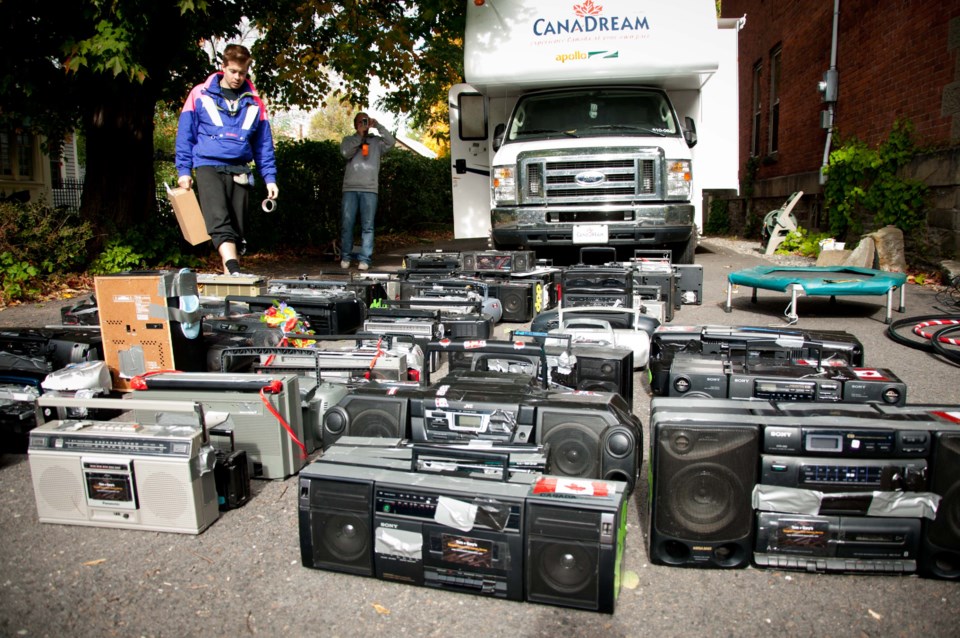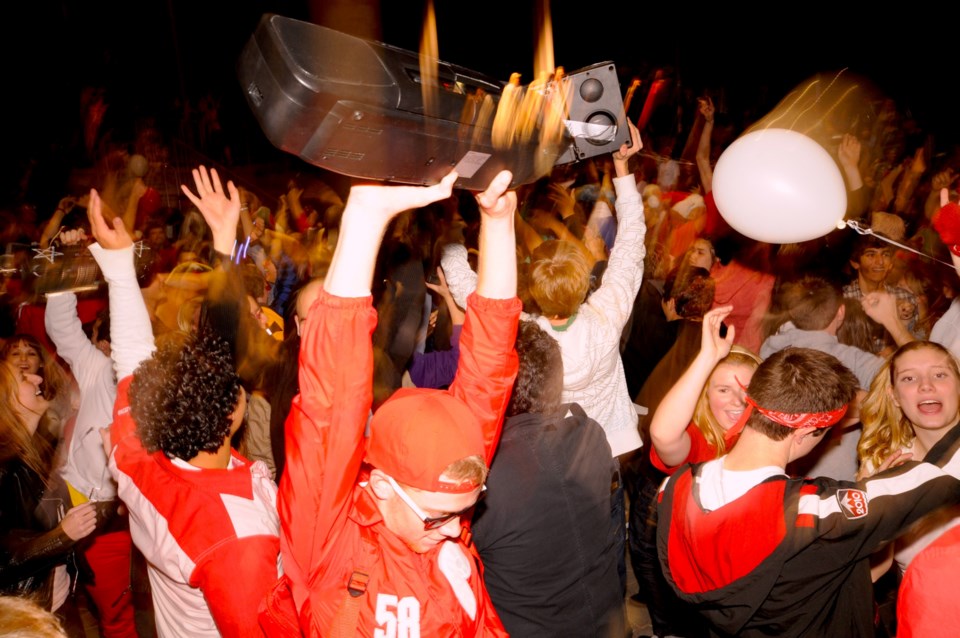Those who love peace must learn to organise as effectively as those who love war.
–Martin Luther King–
For six years, Gary LaChance has been devoted to a theory suggesting that the organized act of partying can bring about world peace.
While many see partying as a self-destructive yielding to temptation – reserved for the occasional indulgence – LaChance pursues the act with calculated intent. Where Western culture stresses the importance of productivity and views partying as irresponsible, LaChance feels a responsibility to save the culture with party after productive party, imploring people to “throw on a ridiculous costume, because you cannot party in normal clothing or look cool. Nothing is cool except having fun, feeling good and sharing that with others.”
Sure, the act of playing loud music and shaking what your biological mother and father gave you can be good for a release after a hard week of work – but could it actually save the world?
For us to better understand his argument, the small-town-turned-big-city-only party planner directs the conversation to a book written by Barbara Ehrenreich, entitled Dancing In The Streets (A History of Collective Joy), adding: “In the days of the colonialists [they came to realise that] every culture had amazing party rituals where the whole community would get together and beat on drums, dance all night and get into a collective state of ecstasy and transcendence. They thought of it as their religion and spirituality, their centrepiece of the whole culture. It’s a fundamental piece of our culture that has been stamped out, marginalised, and thought of as evil.”
Anyone who has been to a rave or music festival can speak to the trance-like state that overtakes the mind and body through dance. The overall oneness and kinship with thy neighbour, Ehrenreich argues, “was stripped out of our culture when colonial regimes defined spectacles as an inherently ‘primitive’ acts and elders harrumphed at youthful exultation.” Both Ehrenreich and LaChance propose that it was this suppressive mindset that led to publicly sanctioned revelry being less prominent in society today.
Ehrenreich affirms that, by subduing the urge to do the mash-potato as a culture, we forgo the natural “oxytocin and serotonin” release, which is then replaced by a pursuit of a synthetic means of achieving oneness or euphoria.
So, in 2009, LaChance and friend Tom Kuzma started what’s called the Decentralized Dance Party (DDP). The DDP is essentially a traveling, often theme-based soirée without the confines of walls or permits. Through the use of a large transmitter and upwards of a few hundred boom boxes, this next-generation flash mob pops up in cities around the world to bring the capital “P” Party.
This year, they’re aiming to #SaveLove by launching a simultaneous street party in Vancouver, San Francisco and Austin, Texas, on Valentine’s Day (Feb. 14) from 7pm-11pm.
“The War on Love is real,” says the party's description. “Across the globe, there are countless forces that seek to corrupt, commodify, and co-opt the ways in which we express our love for each other and ourselves. Recognizing this, we’ve taken a stand, seeking to reinvent Valentine’s Day as a spontaneous night of high-energy celebration and unconditional love between strangers.”

Asked about the DDP’s origins during a recent phone conversation with the Westender, LaChance explained: “Starting out here in Vancouver we were small, and by the time we reached the [2010] Olympics, it had gone from 20 to 20,000 people. Once we had blown it up to that degree, the next step was to start touring. We did a couple tours each across Canada and the U.S., collecting about 600 hours of video footage in the process. The idea was to take that [footage)] and create a really amazing documentary to use in the launch of a world tour.
“The Kickstarter for that started in 2013,” he continues, “and we’ve been working on creating that ever since.”
Though the world tour has yet happen, the movement received a shot in the arm from Vice UK, when they were invited to do a mini-documentary in London, England.
Having laid the foundation for the open-source party policy in Canada, the United States, Germany, Greece and Italy, to name a few, Gary’s goal to “deliver the Global Party Pandemic to every single country on the face of the earth and win the Nobel Prize for partying” is well underway. When Gary says "every country", he means it, adding it “shall include the fabled ‘Stan Tour’ of Afghanistan, Pakistan, Uzbekistan, Tajikistan, Turkmenistan, Kyrgyzstan, Kazakhstan, Transnistria.”
Decentralising, and Rayovac Batteries
The Decentralized Dance Party movement is not unlike the other decentralising initiatives, such as crypto-currency and decentralized environmentalism, or the en vogue decentralized government. On the one hand, there are massive differences in execution or variances in core definition; however, what they share is the pursuit of a profound shift in power away from individuals or conglomerates and back to the people. In simple terms, decentralization is often about cutting out the middleman.
“Once you get into writing stuff down, and rules and copyrights, proprietaries, etc., it's just like everything else, you're not building the new world that we set out to create,” says LaChance. “The goal of the DDP is to be a community-resource that is totally open for anyone to follow, adapt and use. I have been working on a DDP field manual-type strategy guide for anyone [to use] on how to host your own party anywhere in the world.
“It’s set up as a self-governing cultural thing because I'm Decentralist,” he continues. “I have this whole philosophy of Decentralism. I don’t believe that intellectual property should be in existence. I think [intellectual property] is one of the fundamental things that is holding us back from deconstructing all of the world's powers”
Because the DDP is a decentralized movement, finding suitable sponsors is near on impossible without it becoming what the founders set out to dismantle. Due to that, Rayovac Batteries serves as the lone sponsor of the DDP events – batteries being a necessity with how the DDP manages its music. In the days leading up to an event, a host of volunteers will raid thrift stores, classified sections and garage sales in hopes building a stockpile of hundreds of ghetto blasters. They then sticker and battery the sound systems and tune them into a specific frequency. Using a giant transmitter, Kuzma and LaChance are able to broadcast the same song over the hundreds of boom boxes within range.
The Psychology of Law
With an unpredictable number of people involved, though, is police interference a reality?
“We haven't gotten a single fine or ticket yet in almost seven years,” LaChance proudly reveals.
An almost mind-boggling claim, LaChance attributes this to his obsessive attention to detail and the "hundreds of hours" he spends "dissecting the photos, the promos, and the marketing. Making sure that the people they attract are good-hearted people.”

LaChance also created The Party Manifesto (aka the "Seven Commandments of Successful Partying"), which dictates that attention towards the following seven elements is mandatory to achieve successful partying:
● Clothing: As cheesy or extravagant with the theme as possible
● Props: “Pogo sticks, hula-hoops, trampolines, beach balls, jump ropes.”
● Music: “Infectious, high-energy stuff that will force everyone to sing and dance. Booty bass, Eurodance, party metal, jock jams and choice hard rock. The songs people know and love.”
● Dancing: Stop thinking and just dance.
● Behaviour: Allow yourself to step outside yourself, be creative and indulge your inner child.
● Location: LaChance shares that “It is better to party outdoors DDP-style. You cannot party indoors and do it right without wrecking your house. Partying in a club means you have to be of age and spend a ton of money, and the atmosphere is controlled. There’s a curfew and you can’t bring props inside."
● Alcohol: The reason people drink so much at parties is due to their parties being boring. No props, stuffy clothing, poor music and being trapped inside makes one drink.
Of course, the same gathering of carefree lovers could turn into an uncontrollable mob of death merchants if the stimulus is not as noble as that of the DDP. LaChance saw that first hand during Vancouver's Stanley Cup hockey riots in 2011. Gary was in the belly of the orca whale during the looting.
"Before that, I had heard of the 'mob-like mentality'. It was interesting to see all these people, and 80-90 per cent of them were mostly young people that weren't drunk," he recalls. "They had this blank and vacant look in their eyes, like they had become this monster organism that was bent on destroying and burning everything that they could get their hands on. By creating the decentralized sound system, we are able to catalyze the opposite of that, with happy mobs that sweep everybody up, and are totally infectious.”
But what of the police? Surely they can’t be happy about the inevitable open alcohol and minors in the mix. And with all those props comes a trail of debris. (Ever see the floor after a rave with the lights on?)
“Being able to speak through the hundreds of boom boxes gives us a unique form of crowd control,” LaChance explains. “We can tell people to get off sidewalks and get out of the way of stuff. Part of it is my psychotic attention to detail ahead of time, like, for example, when we did the cross-Canada tour it had a Canadian theme. We are celebrating Canada. Who is going to shut us down with all of the costumes and balloons, high energy and happy music?
“The police see it and they understand that we are not a threat, so that's beneficial. I think that cops get a bad rap,” he continues. “Besides, they love it. [All of a sudden] they can come and chaperone a party. They are humans too, so usually when the police show up I'll say, ‘Look, everybody, the cops are here to help us, give them three cheers’. Immediately they know. How often do cops get cheered when they show up to big groups of people?”
As for the DDP’s immediate goals?
“For the summer we really want to team up with the CBC and do a Canada wide party where they broadcast our audio for a couple hours across the nation. Then people can use this app we have been working on we called the Tinder of Partying. Basically, you hit the party button and see if there's anybody else who wants to party in your area. So far,” he adds, “CBC has been next to completely unresponsive to the Canada wide Dance Party.
• To learn more about the DDP's Feb. 14 event, click here.
70th DDP Party has STARTED!
— Tom and Gary's DDP (@ddpFTW) August 21, 2016
Download the DDP App and find us! https://t.co/qyaHm1kca2 (Turn up the volume) pic.twitter.com/63JiNhEdPV


